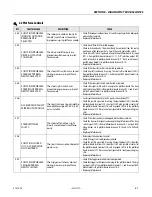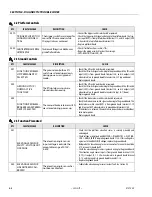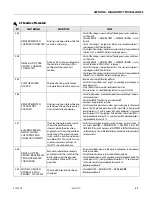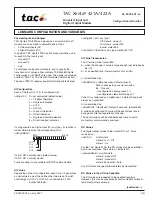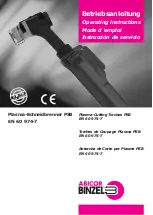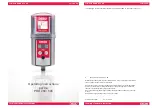
SECTION 7 - JLG CONTROL SYSTEM
3121222
– JLG Lift –
7-13
7.5
TILT SENSOR ELECTRICAL EVALUATION
This basic check using the JLG Analyzer can be used to
test the Tilt Sensor.
• If angle measurements read +20.0, then a sensor/
wiring/connector fault exists.
If the readings inter-
mittently display expected angles, then there is likely
a wiring/connector problem and not a failed sensor.
In either case, open the ES Ground box. Disconnect
the sensor, check the wire terminations, and clean
any corrosion on the tilt sensor and control board
connections. Reconnect and test. If the fault persists,
replace the tilt sensor and return the faulty tilt sensor
to JLG with a detailed description of the diagnostic
steps taken.
7.6
ELEVATION ANGLE SENSOR ELECTRICAL
EVALUATION
These basic checks using the JLG Analyzer can be used
to test the Elevation Atrecrqwetngle Sensor. If the prob-
lem is still occurring, perform the Tilt vs. Allowed Height
Evaluation described below.
• On a level surface, with the Analyzer under DIAG-
NOSTICS/ELEV SENSOR, verify that the elevation
angle sensor voltage increases (ranges from 0.2V-
0.8V to 3.6V-4.2V) with platform height.
If not,
check the sensor mounting. If necessary, unbolt sen-
sor and rotate by hand while monitoring with the
Analyzer to check the integrity of the sensor output.
• For machines equipped with an elevation proxim-
ity switch, if the Elevation Sensor appears satis-
factory, verify that the Elevation Prox switch is
opening and closing appropriately
by watching
the change of state between the stowed and ele-
vated positions (monitor PROX SWITCH under DIAG-
NOSTICS/ELEV SENSOR). If a change of state is not
observed, check prox mounting and operability by
placing metal in front of the prox sensor face.
Tilt vs. Allowed Height Evaluation
First, find a level surface (not just flat like a parking lot;
must be level). The surface should be a plane in which the
wheels are within 0
°±
0.2
°
. Find this surface by taking a
digital level and measuring the areas on which the wheels
would rest in both the X and Y directions. Mark the loca-
tions and drive the machine to these points. If a level sur-
face can not be found, flat shims or plates may be place
under the wheels to create a level plane for the wheels.
In determining the existing tilt angle, read the angle on
the Analyzer under DIAGNOSTICS/SYSTEM. Do not place a
hand-held level on the machine to determine whether the
machine is level and lifting to the appropriate height. Such
a measurement will likely be different than the Ground
box/tilt sensor angle reading due to manufacturing and
mounting tolerances. The tilt angle in both directions
should read within
±
0.5
°
while on a level surface. If not,
then either the machine has a drifting tilt sensor or has
been erroneously re-calibrated since the original factory
calibration.
Check the service records to determine whether a re cali-
bration has been performed. If so, re-calibrate on the level
surface. If there is no record of an earlier calibration, we
must assume that the sensor output has drifted. There-
fore, replace the sensor and return to JLG with a detailed
troubleshooting description.
NOTE:
There is a rare case in which an attempted calibra-
tion will be unsuccessful for machines with Ground
module software version P1.5 or earlier. If this occurs
while performing a calibration, the Analyzer will dis-
play:
LEVEL VEHICLE
TILT +20.0 +20.0
and the following fault will also be logged
.
TILT SENSOR NOT CALIBRATED (2/3) [DTC 811]
If no other faults have been logged since the last startup,
this fault indicates that the software needs to be updated
to P1.6 or later. Update the software and continue trouble-
shooting evaluation before replacing any components.
If the tilt sensor readings are within range for a level
machine, compare the allowed Tilt vs. Height in the chart
below. Being within 6” of the target height is considered
acceptable.
NOTE:
For Japanese specification machines labeled “Minis-
try of Labor Notification #70,” the Tilt Setting is 5
degrees (front to back and side to side) regardless of
elevated platform height.
If the machine does not appear to track the lift cutout
heights and no fault exists as described above, stow the
machine and re-calibrate the Elevation Sensor.
Table 7-5. Tilt Cutout Settings
1230ES
Tilt Setting
(front to back)
Tilt Setting
(side to side)
ANSI/CSA
3°
1.5°
CE/AUS
3.4°
3.4°
Summary of Contents for 1230ES
Page 1: ...AS NZS Service and Maintenance Manual Model s 1230ES P N 3121222 June 22 2017 ...
Page 2: ...NOTES ...
Page 24: ...SECTION 1 MACHINE SPECIFICATIONS 1 12 JLG Lift 3121222 NOTES ...
Page 32: ...SECTION 2 GENERAL SERVICE INFORMATION 2 8 JLG Lift 3121222 NOTES ...
Page 78: ...SECTION 4 BASE COMPONENTS 4 40 JLG Lift 3121222 NOTES ...
Page 104: ...SECTION 5 CONTROL COMPONENTS 5 26 JLG Lift 3121222 NOTES ...
Page 158: ...SECTION 8 DIAGNOSTIC TROUBLE CODES 8 22 JLG Lift 3121222 NOTES ...
Page 198: ...SECTION 9 GENERAL ELECTRICAL INFORMATION SCHEMATICS 9 40 JLG Lift 3121222 ...
Page 199: ...SECTION 9 GENERAL ELECTRICAL INFORMATION SCHEMATICS 3121222 JLG Lift 9 41 ...
Page 200: ...SECTION 9 GENERAL ELECTRICAL INFORMATION SCHEMATICS 9 42 JLG Lift 3121222 ...
Page 202: ...SECTION 9 GENERAL ELECTRICAL INFORMATION SCHEMATICS 9 44 JLG Lift 3121222 NOTES ...























